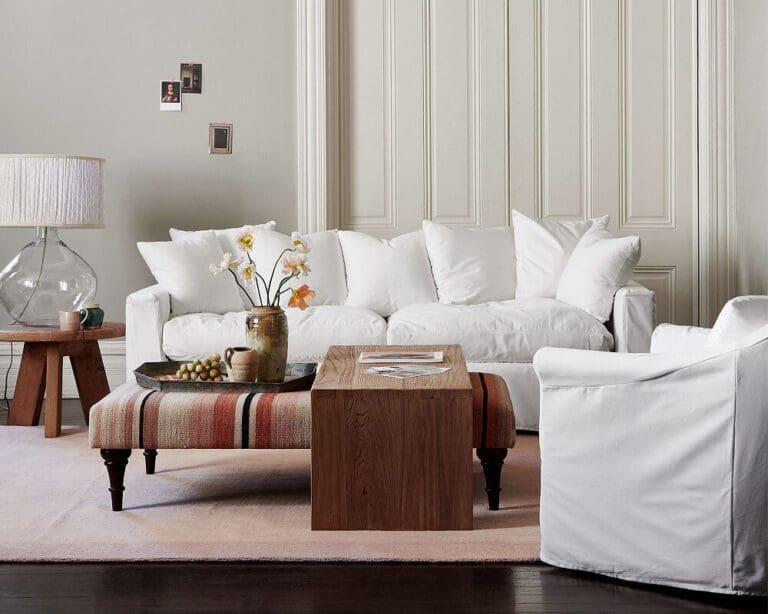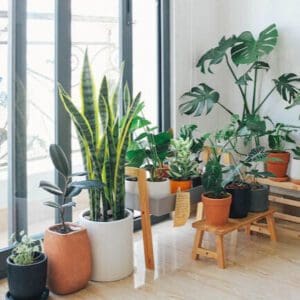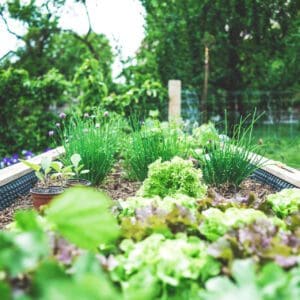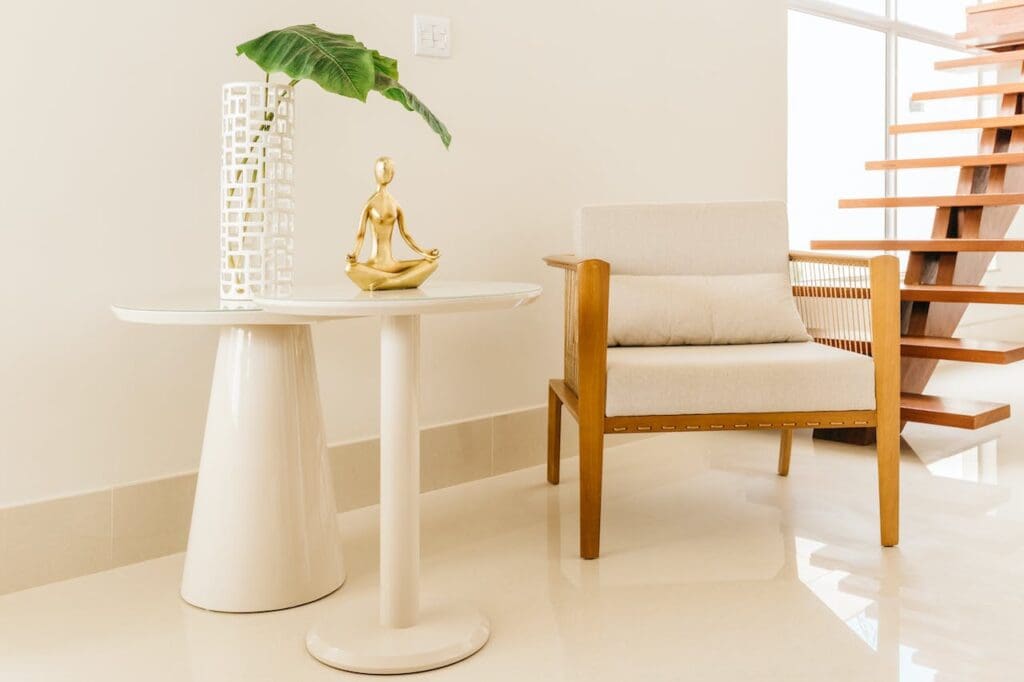In this post, we share expert opinions on up-and-coming sustainable interior design trends.
The Home Green is reader-supported and may receive a commission if you decide to make a purchase through a posted link, at no cost to you.
It’s that time of year when we all take a mental recap of the year that has passed and consider what’s to come. As news regarding the state of our planet becomes more dire, many of us look for new ways to improve the sustainability of our lifestyles. At The Home Green, we find it hopeful to see sustainable interior design trends growing and becoming more top of mind among shoppers and the larger interior design industry – and we're not the only ones noticing it!
“We at PURE Design have been engaged in the shift toward sustainable interior design for years, and in 2023 I noticed it catching on in the mainstream consciousness and I love it! I see it as a buzzing topic everywhere and that’s a great thing.”
– Ami McKay, PURE Design Inc.
Another exciting signal that sustainable interior design trends are becoming mainstream is the fact that Williams Sonoma launched a green-focused brand, GreenRow, to its stable of popular furniture and home goods shops. This isn’t the first sustainability-focused brand in the space, but it’s certainly notable to see an established giant betting on the future of sustainable home goods.


Image courtesy of GreenRow
We were curious what sustainable interior designers were noticing among their clients, so we reached out to some of the most active designers and firms in this space to get their invaluable perspectives. They shared what they’re excited about and some great ideas on how you can replicate these sustainable interior design trends in your home!
1. Increasing our environmental connection in our home design
While pure altruism is a great reason to make your home more sustainable, there are also more selfish benefits – it turns out that connecting with nature can make us happier and healthier!
Sarah Barnard, sustainable Interior Designer and owner of Kale Tree explains:
“There is a growing interest in creating homes that work symbiotically with their environmental surroundings and are considerate of the local climate. Studies suggest that spending time in and observing our natural surroundings can help promote mindfulness and other health benefits. Incorporating Biophilic design into our homes helps alleviate stress and burnout.”


If you haven’t investigated biophilic interior design yet, this is the year to do it. When it comes to interior design, biophilic ideas help us create a two-sided relationship with our surroundings. This means that not only are we looking to be good stewards of nature because it’s our duty but also because nature gives an awful lot back to us in terms of mental health and wellbeing. Designing our homes to incorporate elements of nature just may have a positive impacts on how happy we are in that space.
Another design style to become familiar with is holistic interior design which also aims to consider the entirety of interior design, including how eco-friendly it is and how it impacts the people in it. Unlike biophilic interior design, it focuses on more than just nature to include the energy and flow of a space.
2. Looking in our own backyards for sustainable interior design trends


The locavore movement has taught us the benefits of all things local over the past 15+ years. Many of the benefits of sourcing food locally can extend to other parts of our lives and our experts are seeing this movement expand even more into the interior design space in the future.
“Working with local artists/artisans can offer more transparency about how products are produced and reduce the carbon footprint from transportation. Working with smaller design companies can also foster closer relationships that generate customized items that will live with us for a long time as they directly meet our personal needs and tastes. When sourced locally, materials can also create social sustainability as they connect us to a community of artisans and craftspeople, building personal connections, and investing back into our neighborhoods.”
3. Returning to quality
While 2020 was the year many of us tackled those home projects with whatever we could get our hands on, since then, many in the industry are noticing a return to considering the longevity of the things we buy. Consumers are figuring out that buying high quality doesn’t have to mean breaking the bank, particularly if you’re willing to get a little creative in where you buy your home goods.
Shopping for second-hand items is becoming more popular across industries and one of the reasons is certainly to take advantage of being able to purchase high-quality pieces with a more reasonable price tag. While online second-hand furniture retailers like Chairish, Kaiyo, and AptDeco are growing, second-hand furniture is becoming so mainstream that even IKEA is getting into the game.
4. Considering waste in sustainable interior design trends
Of course, one of the primary reasons to buy high-quality items is to reduce waste. Katie Storey, as the founder of Storey Design and also the Good Future Design Alliance, has a unique perspective on what’s in demand among both clients and designers. She shares one of the biggest sustainable interior design trends she’s noticed:
“We've seen a real interest in low-waste materials and manufacturing. Our members really want to understand how to implement a low-waste project, specifically what products to source and what materials to select. They are looking for high-quality, low-waste products and really wanting to understand how items are manufactured and shipped around the globe.”


5. Reducing toxic materials from our homes
Greater awareness of how interior design materials can be harmful to both the environment and the health of the people in our homes is another of the biggest trends in sustainable interior design our experts are seeing. Interior Designer Katie Storey says:
“I think that in 2024 we're going to see even more emphasis put on non-toxic, low-waste material selection. The message is out about how wasteful the design and build industry is. Now it's time to take steps to reduce our impact.”
Interior Designer Sarah Barnard agrees, sharing the reasons she and her clients are thoughtful about the materials they select:
“Sustainably sourced materials such as FSC-certified woods, mineral-based paints, and eco-friendly fabrics use fewer chemicals in their production. Sourcing organic, sustainable materials is also often better for your health and well-being.”
6. Innovation in materials
If you need some positive news, look no further than the amount of innovation happening in sustainable interior design materials. There are truly many better substitutes for the more harmful materials that we’ve come to rely on.
Ami McKay, Founder of PURE Design Inc. has focused on designing more sustainable homes for years and has great advice for anyone interested in finding more eco-friendly materials for their homes.
“…There are two questions that the interior design industry can ask, (or continue to ask) regarding eco-conscious materials in the design process; 1) which materials are made with the least negative impact on the planet and 2) which materials will have a good long life and when that life is over break down to be reabsorbed by the earth, or can be repeatedly recycled?
Materials to consider: Reclaimed, recycled or sustainable wood, sustainable concrete, steel (it can be recycled again and again), tile and stone, recycled rubber, wool as insulation, cork for floors, ceilings and walls and clay brick are all good options, as well as several materials that are relatively new to designers and builders such as newspaper wood, timbercrete, and enviroboard. All worth looking up!”
Guide to sustainable materials
If you'd like to learn more about sustainable interior design materials, check out our guide.


7. Conservation at home


Exploring the functionality of our homes to uncover where efficiencies can be gained is another of the sustainable interior design trends that seems to be here to stay.
Sustainable interior designer Sarah Barnard explains:
Self-sustaining infrastructure such as solar and grey water systems have become increasingly popular, as well as independent food sources such as vegetable gardens, expanded pantry and freezer storage, and space to dry or preserve food at home.”
Adding solar power and grey water systems can be a major investment but experimenting with your own garden, even in an urban space, can be a fun way to start your journey toward sustainability at home.
Home takes on more meaning
At the heart of all of the sustainable interior design trends we’re noticing is the fact that houses are becoming more than just places we lay our heads. Many of us are spending more time in the four walls of our home and want them to be places we feel comfortable in and good about.
The interior design of our homes can be more than skin deep. Home can be a place of connection that reflects our personalities and values. It’s less satisfying to live in a beautiful space than one that represents, on a small scale, the world you’d like to see manifested at a broader level. We hope you'll consider trying these sustainable interior design trends in your space!
Free tips and inspiration in your inbox
Stay up to date on the latest news in sustainable interior design! Enter your email address below to be included on our newsletter distribution list.


